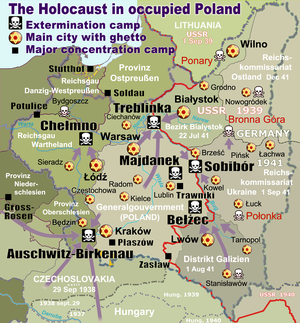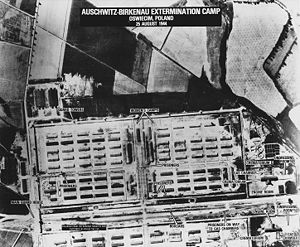Vernichtungslager
| Nazi extermination camps | |
|---|---|

Death Gate at Auschwitz II Birkenau
 The Holocaust map: Nazi extermination camps, marked with white skulls in black squares, set up by the SS in Germany and occupied Poland, 1942 |
|
| Location | German-occupied Europe |
| Date | World War II |
| Incident type | Extermination |
| Perpetrators | SS, Trawnikis, Ustaše |
| Organizations | SS-Totenkopfverbände |
| Camp | Chełmno, Bełżec, Sobibór, Treblinka, Auschwitz, Majdanek, Trostenets |
|
|||||||||||
| U.S. aerial photograph of Auschwitz II Birkenau with location of crematoria (to the right of red mark) |
Nazi Germany built extermination camps (also called death camps or killing centers) during World War II (1939–45) to systematically kill millions of Jews, Slavs, Communists, and others whom the Nazis considered "Untermenschen" ("subhumans"). The victims of what became known as The Holocaust were primarily killed by gassing, but also in mass executions and through extreme work under starvation conditions.
The idea of mass extermination with the use of stationary facilities built exclusively for that purpose was a result of earlier Nazi experimentation with the chemically manufactured poison gas during the secretive Action T4 euthanasia programme against hospital patients with mental and physical disabilities. The technology was adapted, expanded, and applied in wartime to unsuspecting victims of many ethnic and national groups; the Jews however were the primary targets, accounting for over 90 percent of the extermination camp death toll. This genocide of the Jewish people of Europe was the Third Reich's "Final Solution to the Jewish question". It is now collectively known as the Holocaust.
Extermination camps were also set up by the fascist Ustaše regime of the Independent State of Croatia, a puppet state of Germany, carrying out genocide between 1941 and 1945 against Serbs, Jews, Roma and its Croat and Bosniak Muslim political opponents.
...
Wikipedia

